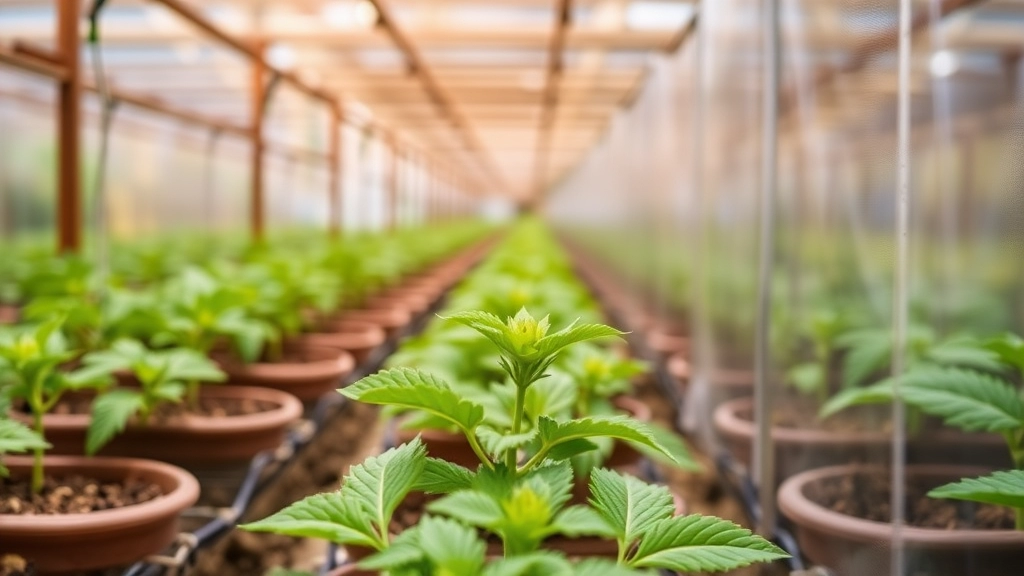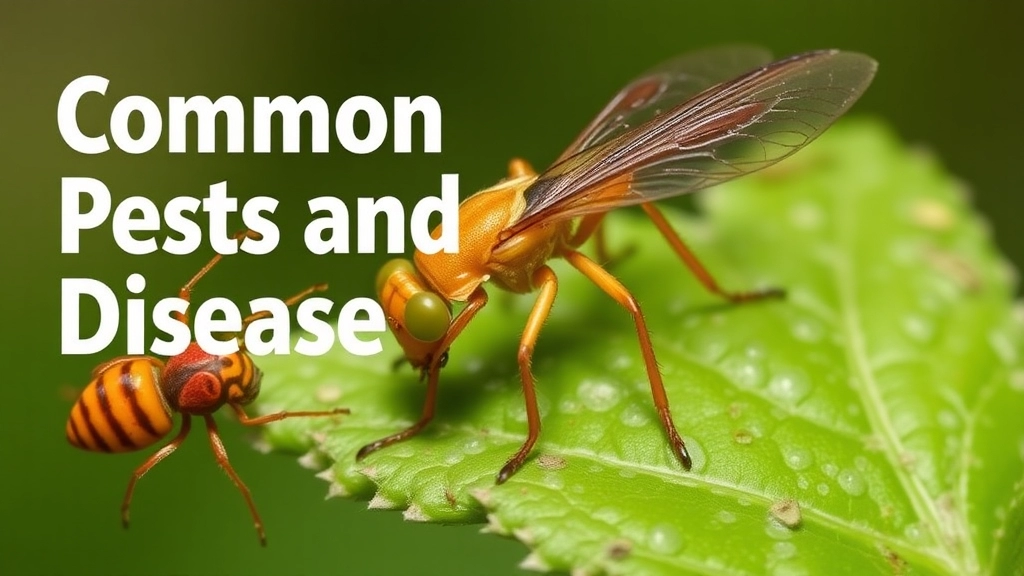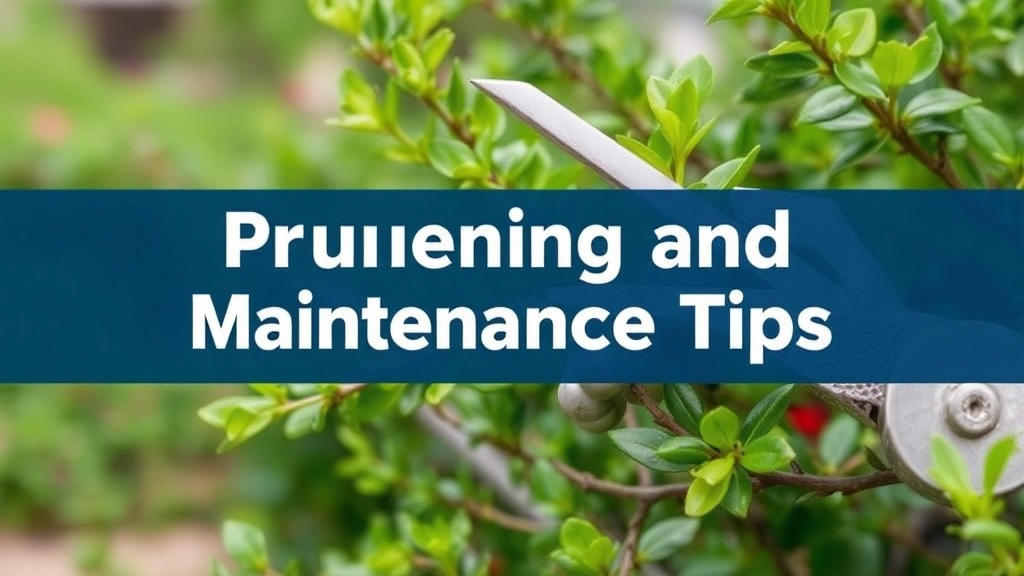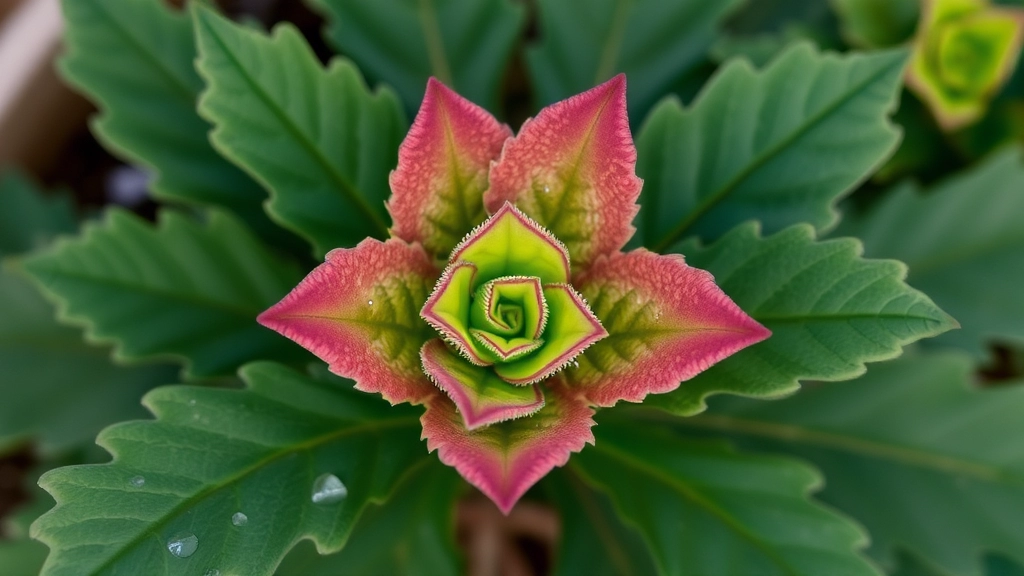Welcome, plant enthusiasts!
Today, we’re diving into the fascinating world of the Kalanchoe beharensis Oak Leaf. This unique succulent, with its velvety, silvery-grey leaves and distinctive oak-like edges, is a true standout in any collection. As we explore its characteristics, care requirements, and benefits, you’ll discover why this plant has captured the hearts of gardeners worldwide.
From its impressive size potential to its low-maintenance nature, the Kalanchoe beharensis Oak Leaf offers a perfect blend of beauty and practicality. Whether you’re a seasoned plant parent or just starting your green journey, this article will equip you with all the knowledge you need to help your Oak Leaf thrive. So, let’s embark on this botanical adventure together and uncover the secrets of this remarkable succulent!
Characteristics of Kalanchoe Beharensis Oak Leaf
Ever seen a plant that looks like it’s straight out of a sci-fi movie? That’s Kalanchoe Beharensis Oak Leaf for you.
This bad boy is a real head-turner in the succulent game.
Picture this: massive, velvety leaves that can grow up to 1 foot long. No joke.
The leaves? They’re not your average green. We’re talking a silvery-grey that’ll make your other plants jealous.
And get this – they’ve got these funky, oak-like edges. Hence the name “Oak Leaf”. Pretty clever, right?
But here’s the kicker – this plant can get huge. We’re talking up to 6 feet tall in the right conditions.
It’s like the Hulk of the succulent world, but way cooler and less angry.
Now, let’s talk texture. The leaves feel like velvet, thanks to tiny hairs covering them.
These hairs aren’t just for show – they help the plant conserve water. Smart, huh?
And if you’re lucky, you might see some flowers. They’re not the main event, but they add a nice touch.
The Kalanchoe Beharensis Oak Leaf is a slow grower, so don’t expect overnight miracles.
But trust me, it’s worth the wait. This plant’s got personality for days.
So, if you’re after a plant that’s as unique as you are, Kalanchoe Beharensis Oak Leaf might just be your new best friend.
Ideal Growing Conditions

Let’s chat about the perfect setup for your Kalanchoe Beharensis Oak Leaf, shall we? This funky little succulent’s got some specific needs, but don’t sweat it â I’ve got you covered.
Light: Sun-loving champs
These guys are total sun worshippers. They’ll thrive in bright, direct sunlight for most of the day. But hey, if you’re in a scorching hot area, a bit of afternoon shade won’t hurt.
Temperature: Warm and cosy
- Ideal range: 15-27°C (60-80°F)
- Can handle brief dips to 10°C (50°F)
- Not a fan of frost â keep ’em protected!
Soil: Well-draining is key
You want a mix that’ll let excess water escape quickly. Think:
- Cactus soil
- Regular potting mix with added perlite or sand
Humidity: Not fussy
Good news â these plants aren’t drama queens about humidity. They’ll do just fine in average indoor conditions.
Airflow: Give ’em room to breathe
Decent air circulation helps prevent fungal issues. No stuffy corners for these beauties!
Pro tip: If you’re growing indoors, pop ’em near a south-facing window for that sweet, sweet sunlight.
Remember, nailing these conditions is like giving your Kalanchoe Beharensis Oak Leaf a VIP pass to Thriving Town. Get these basics right, and you’ll be well on your way to plant parent success.
Any burning questions about setting up the perfect home for your Oak Leaf? Drop ’em in the comments â I’m all ears!
If you’re interested in other Kalanchoe varieties, check out the Kalanchoe Tomentosa, also known as the Panda Plant, for a unique and fuzzy addition to your collection!
Propagation Techniques
Alright, let’s chat about how to make more of these awesome Kalanchoe Beharensis Oak Leaf plants.
It’s easier than you might think, and I’ve got some tricks up my sleeve.
Leaf Cuttings: The Go-To Method
This is my favourite way to do it. Here’s how:
- Snip off a healthy leaf
- Let it dry for a day or two
- Stick it in some well-draining soil
- Keep it moist but not soggy
- Wait for roots to form (usually takes a few weeks)
Stem Cuttings: For the Impatient Gardener
If you want faster results, try this:
- Cut a stem about 4-6 inches long
- Remove lower leaves
- Let it callous over for a day
- Plant in a mix of perlite and cactus soil
- Water sparingly until roots develop
Seeds: The Patient Approach
Not gonna lie, this takes time, but it’s rewarding:
- Sow seeds on top of well-draining soil
- Mist lightly
- Cover with plastic to create a mini-greenhouse
- Be patient – germination can take weeks
Division: The Quick and Easy Way
Got a big plant? Try this:
- Carefully remove the plant from its pot
- Gently separate the roots
- Replant each section in its own pot
Remember, no matter which method you choose, patience is key.
These plants aren’t in a rush, so why should we be?
Got any propagation stories to share? I’d love to hear ’em!
Common Pests and Diseases

Let’s chat about the not-so-fun part of growing Kalanchoe Beharensis Oak Leaf – the pests and diseases that can crash your plant party. Trust me, I’ve been there, and it’s no picnic. But don’t worry, we’ll tackle this together.
Pesky Critters to Watch Out For
- Mealybugs: These little cotton-ball lookalikes love to set up camp on your plant. They’re sneaky, hiding in leaf joints and sucking the life out of your Oak Leaf.
- Spider Mites: Tiny but terrible, these guys can create a fine webbing on your plant. If you see speckling on the leaves, you might have a mite problem.
- Scale Insects: These flat, oval pests attach themselves to stems and leaves, acting like tiny vampires.
Diseases That Might Pop Up
- Root Rot: This is a biggie, folks. Overwatering is usually the culprit here. Your plant’s roots start to decay, and before you know it, your Oak Leaf is a goner.
- Powdery Mildew: Looks like someone dusted your plant with flour. It’s a fungal infection that thrives in humid conditions.
- Leaf Spot: Brown or black spots on the leaves? Could be a bacterial or fungal infection.
How to Keep Your Oak Leaf Healthy
Look, prevention is key here. Keep your plant in tip-top shape by:
- Giving it proper air circulation
- Avoiding overwatering (seriously, this is crucial)
- Regularly inspecting your plant for any signs of trouble
If you do spot an issue, don’t panic. Isolate the affected plant, prune off damaged parts, and treat with appropriate pesticides or fungicides. Remember, organic options are available if you’re not keen on chemicals.
Bottom line: Keeping an eye out for these common pests and diseases will help your Kalanchoe Beharensis Oak Leaf thrive. It’s all about being proactive and nipping problems in the bud (pun intended). If you’re looking for more tips on caring for other Kalanchoe varieties, check out our guide on Kalanchoe Beharensis care.
Watering and Fertilization Needs
Let’s talk about keeping your Kalanchoe Beharensis Oak Leaf happy and thriving.
Watering: The Golden Rule
These succulents are thirsty, but not too thirsty. Here’s the deal:
- Water when the top inch of soil feels dry
- Don’t let it sit in water – drainage is key
- Less water in winter, more in summer
Think of it like this: you wouldn’t chug a gallon of water in one go, right? Same for your plant.
Fertilization: Feed Me, Seymour!
Your Oak Leaf isn’t a big eater, but it does need some nutrients:
- Use a balanced, water-soluble fertilizer
- Feed every 4-6 weeks during growing season
- Skip fertilizing in winter – let it rest
Pro tip: Dilute the fertilizer to half strength. Better to underfeed than overfeed.
The Goldilocks Zone
Finding the right balance is crucial. Too much water or fertilizer? You’re asking for trouble.
Signs you’re overdoing it:
- Yellowing leaves
- Soft, mushy stems
- Fungus gnats partying in the soil
Signs you’re underdoing it:
- Droopy leaves
- Slow growth
- Pale, lackluster appearance
Remember, it’s all about balance. Your Kalanchoe Beharensis Oak Leaf will tell you what it needs if you pay attention.
Bottom line: Water when dry, feed lightly, and let your plant guide you. It’s not rocket science, but it does take a bit of practice.
Pruning and Maintenance Tips

Let’s chat about keeping your Kalanchoe Beharensis Oak Leaf looking its best. I’ve learned a thing or two about pruning and maintaining these beauties, and I’m excited to share some tips that’ll make your life easier.
Pruning: When and How?
First things first, when should you prune? Well, I usually go for it in early spring or late winter. Why? It’s when the plant’s not actively growing, so it’s less stressful for our leafy friend.
Here’s my quick and dirty pruning guide:
- Grab clean, sharp scissors or pruning shears
- Cut just above a leaf node (where leaves meet the stem)
- Remove any dead, damaged, or yellowing leaves
- Trim back leggy stems to encourage bushier growth
- Don’t go overboard – aim to remove no more than 1/3 of the plant
Maintenance: Keeping Your Oak Leaf Happy
Now, let’s talk about keeping your Kalanchoe in tip-top shape:
- Dust those leaves: A damp cloth works wonders for wiping down dusty leaves. It’s like a mini spa day for your plant!
- Check for pests: Give your plant a once-over every week or so. Catch those pesky bugs early, and you’ll save yourself a headache later.
- Rotate regularly: Turn your plant a quarter turn every week. It’ll grow more evenly and look fuller.
- Clean up fallen leaves: Don’t let dead leaves pile up. They can attract pests and disease.
- Support if needed: If your Oak Leaf gets top-heavy, don’t be shy about using stakes or a trellis for support.
Troubleshooting Common Issues
Sometimes, despite our best efforts, things go a bit pear-shaped. Here are a few issues I’ve run into and how I’ve sorted them:
- Leggy growth: If your plant’s stretching out, it’s probably not getting enough light. Move it to a brighter spot and prune back the lanky bits.
- Yellowing leaves: This could be overwatering or underwatering. Check the soil moisture and adjust your watering schedule.
- Brown leaf tips: Often a sign of low humidity. Try misting the leaves or using a pebble tray.
Remember, pruning and maintenance aren’t just chores – they’re your chance to bond with your Kalanchoe Beharensis Oak Leaf. It’s all about keeping an eye on your plant, understanding its needs, and giving it a little TLC. With these tips in your back pocket, you’ll be well on your way to having a thriving, happy Oak Leaf tree that’ll be the envy of all your plant-loving mates.
Indoor vs. Outdoor Growing
Let’s chat about growing Kalanchoe Beharensis Oak Leaf indoors vs outdoors.
Ever wondered which is better? I’ve tried both, and here’s the scoop.
Indoor Growing:
- Perfect for those with limited outdoor space
- Easier to control temperature and humidity
- Protection from harsh weather and pests
- Ideal for colder climates where frost is a risk
But here’s the catch – they need plenty of bright, indirect light.
Outdoor Growing:
- Thrives in warm, sunny spots
- Grows larger and more robust
- Natural rainfall can help with watering
- Better air circulation, reducing fungal issues
The downside? You’ve got to watch out for extreme weather.
So, which is best?
Honestly, it depends on your climate and space.
In the UK, I’d lean towards indoor growing most of the year.
But if you’ve got a sheltered spot in your garden, why not try both?
Remember, Kalanchoe Beharensis Oak Leaf is pretty adaptable.
The key is giving it the right light, whether that’s indoors or out.
Experiment a bit, see what works for you and your plant.
At the end of the day, growing Kalanchoe Beharensis Oak Leaf is all about finding that sweet spot, indoors or outdoors.
Benefits of Kalanchoe Beharensis Oak Leaf
Let’s chat about why the Kalanchoe Beharensis Oak Leaf is such a game-changer in the plant world. Trust me, I’ve been around the block with plants, and this one’s got some serious perks.
Air Purification Powerhouse
First off, this bad boy is like a natural air filter. It’s not just sitting there looking pretty; it’s actively cleaning the air you breathe. How cool is that?
- Removes toxins like formaldehyde and benzene
- Boosts oxygen levels in your space
- Helps reduce indoor air pollution
Low Maintenance Marvel
Look, we’re all busy. Who’s got time to fuss over a plant 24/7? That’s where the Oak Leaf shines.
- Thrives on neglect (perfect for forgetful folks like me)
- Drought-tolerant (forgot to water? No biggie)
- Rarely needs repotting
Stress Buster
Ever had one of those days where everything’s going wrong? This plant’s got your back.
- Its presence can lower stress levels
- Boosts mood and productivity
- Creates a calming atmosphere in any room
Unique Aesthetic Appeal
Let’s be real, it’s a looker. The Oak Leaf stands out in any plant collection.
- Distinctive, velvety leaves
- Interesting texture adds depth to your decor
- Conversation starter for plant enthusiasts
Versatility
This plant’s not a one-trick pony. It’s got range, baby.
- Works in various settings (indoor, outdoor, office)
- Can be grown as a houseplant or in a garden
- Suitable for different climates with proper care
Medicinal Properties
Now, I’m not saying it’s a miracle cure, but it’s got some interesting potential.
- Traditional uses in some cultures for wound healing
- Contains compounds being studied for anti-inflammatory properties
- May have antimicrobial effects (research ongoing)
So, there you have it. The Kalanchoe Beharensis Oak Leaf isn’t just another pretty face in the plant world. It’s a multitasking marvel that can purify your air, boost your mood, and maybe even help with a few health niggles. Plus, it looks damn good doing it. What’s not to love?
Remember, though, while this plant’s got a lot going for it, it’s always best to do your own research and chat with experts if you’re thinking of using it for anything beyond decoration. Safety first, plant pals! If you’re interested in other unique Kalanchoe varieties, check out the Kalanchoe Beharensis cv. Fang for another fascinating option.
Popular Varieties and Hybrids
Let’s dive into the world of Kalanchoe Beharensis Oak Leaf varieties and hybrids.
Trust me, there’s more to this plant than meets the eye.
First up, we’ve got the classic ‘Fang’ variety.
It’s got these wicked tooth-like edges that’ll make you do a double-take.
Then there’s ‘Silver Elephant’, with leaves so fuzzy you’ll want to pet them.
But wait, there’s more!
‘Feltleaf’ is another stunner, boasting massive leaves that feel like velvet.
For those who like a bit of colour, ‘Bronze Sculpture’ is your go-to.
Its coppery tones will add some serious pizzazz to your plant collection.
Now, let’s talk hybrids.
Kalanchoe ‘Fantastic’ is a cross between K. beharensis and K. millotii.
It’s got the best of both worlds – tough and beautiful.
Another cool hybrid is ‘Copper Spoons’, a mix of K. beharensis and K. orgyalis.
Its spoon-shaped leaves are a real conversation starter.
Here’s the thing about these varieties and hybrids:
- They’re all drought-tolerant champs
- Each has its unique look and vibe
- They’re perfect for both newbies and plant pros
So, which Kalanchoe Beharensis Oak Leaf variety or hybrid catches your eye?
Remember, no matter which one you choose, you’re in for a treat with these fascinating plants.
Troubleshooting Common Issues
Alright, let’s dive into the nitty-gritty of Kalanchoe Beharensis Oak Leaf problems. Trust me, I’ve been there, scratching my head over why my plant’s looking a bit off. But don’t worry, we’ll sort it out together.
Common Hiccups and How to Fix ‘Em
1. Yellowing Leaves
Ever walked up to your Oak Leaf and thought, “Mate, why’re you looking so yellow?” Here’s the deal:
- Overwatering: Ease up on the H2O, champ. These succulents like it dry.
- Nutrient deficiency: Time for a feed. Go for a balanced, water-soluble fertiliser.
2. Drooping or Wilting
If your plant’s looking sadder than a wet weekend, it might be:
- Underwatering: Give it a good drink, but don’t go overboard.
- Too much sun: Move it to a spot with bright, indirect light.
3. Brown, Crispy Leaf Edges
This is your Oak Leaf’s way of saying, “Oi, I’m thirsty!” or “It’s too hot in here!”
- Water more frequently, but let the soil dry between waterings.
- Move to a cooler spot if it’s getting scorched.
4. Slow Growth
If your Kalanchoe’s not putting on size like it should:
- Check the light: These guys need bright light to thrive.
- Repot if it’s rootbound: Give those roots some room to stretch.
5. Pest Invasion
Spotted some uninvited guests? Here’s how to show them the door:
- Mealybugs: Dab with rubbing alcohol on a cotton swab.
- Spider mites: A good shower and some neem oil should do the trick.
Remember, every plant’s a bit different. What works for one might not work for another. It’s all about getting to know your Oak Leaf and what makes it tick. Keep an eye on it, adjust as needed, and you’ll be golden.
Got any other issues you’re facing with your Kalanchoe Beharensis Oak Leaf? Drop ’em in the comments, and let’s troubleshoot together. After all, plant parenthood is a journey, and we’re all in this together!
FAQs about Kalanchoe Beharensis Oak Leaf
1. How often should I water my Kalanchoe Beharensis Oak Leaf?
Water your Oak Leaf when the top inch of soil feels dry. This typically means watering every 1-2 weeks, but it can vary depending on your climate and the plant’s environment. Remember, it’s better to underwater than overwater these succulents.
2. Can I grow Kalanchoe Beharensis Oak Leaf outdoors?
Yes, you can grow Oak Leaf outdoors in warm climates (USDA zones 9-11). However, it needs protection from frost and extreme heat. If you live in a colder area, it’s best to grow it as a houseplant or bring it indoors during winter.
3. Why are my Oak Leaf’s leaves turning yellow?
Yellowing leaves can be a sign of overwatering, nutrient deficiency, or insufficient light. Check your watering routine first, then consider fertilizing or moving the plant to a brighter location if needed.
4. How big does Kalanchoe Beharensis Oak Leaf grow?
In ideal conditions, Oak Leaf can grow up to 6 feet tall. However, when grown indoors, it typically stays smaller, around 2-3 feet tall. Growth rate is generally slow to moderate.
5. Is Kalanchoe Beharensis Oak Leaf toxic to pets?
Yes, like many Kalanchoe species, Oak Leaf can be toxic if ingested by pets. It’s best to keep it out of reach of cats, dogs, and other curious animals.
6. How do I propagate my Oak Leaf plant?
The easiest way to propagate Oak Leaf is through leaf or stem cuttings. Allow the cutting to callous over for a day or two, then plant it in well-draining soil. Keep the soil lightly moist until roots develop.
7. Why does my Oak Leaf have brown, crispy leaf edges?
Brown, crispy edges often indicate underwatering or low humidity. Try increasing your watering frequency slightly or misting the leaves occasionally to boost humidity.
8. How much light does Kalanchoe Beharensis Oak Leaf need?
Oak Leaf thrives in bright, indirect light. It can tolerate some direct sunlight, especially in the morning, but too much intense sun can scorch the leaves. If growing indoors, a south-facing window is ideal.
References
-
Kalanchoe beharensis – Feltleaf Kalanchoe, Velvet Leaf https://worldofsucculents.com/kalanchoe-beharensis-feltleaf-kalanchoe-velvet-leaf/
-
Kalanchoe beharensis (Felt Plant) | World of Succulents https://worldofsucculents.com/kalanchoe-beharensis-felt-plant/
-
Kalanchoe beharensis – Wikipedia https://en.wikipedia.org/wiki/Kalanchoe_beharensis

